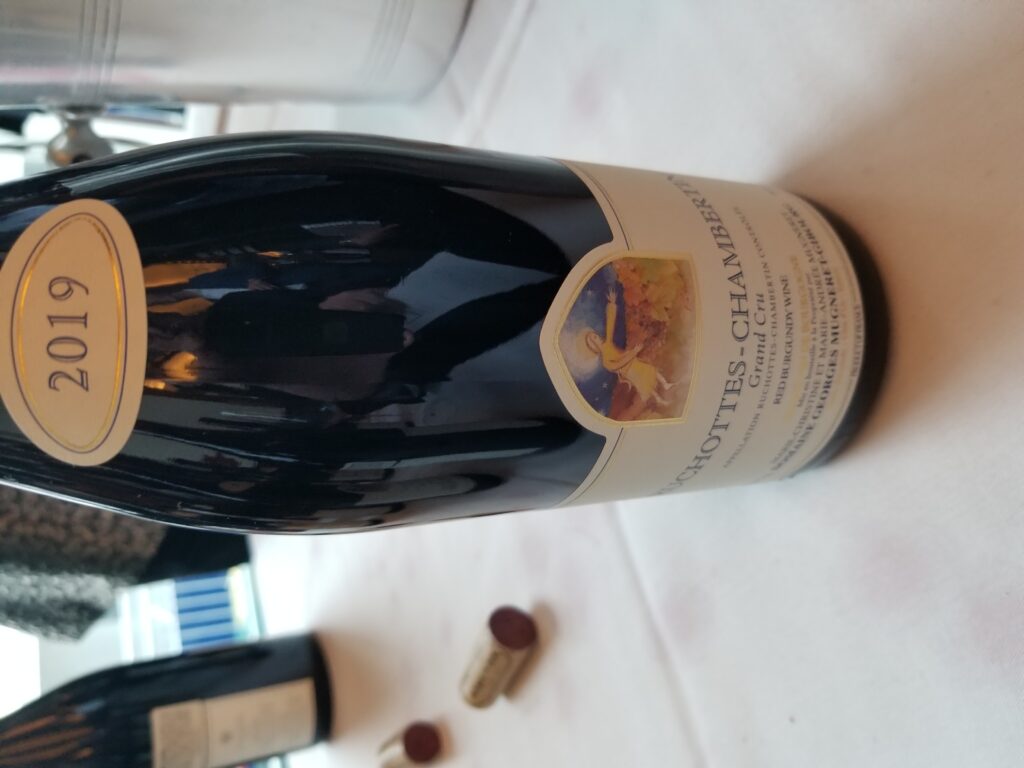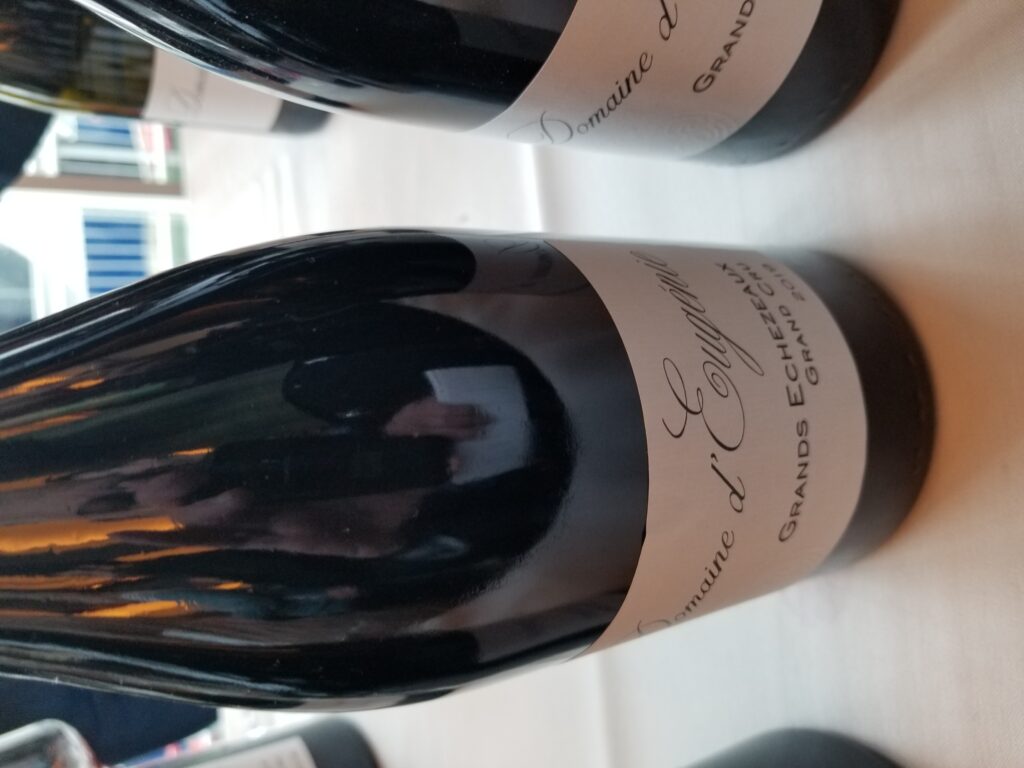Also see: White Burgundies at La Paulee NYC 2022
On a dreary, rainy Saturday in early March, hundreds assembled at Pier 60 in Manhattan to taste red and white Burgundy from 40 estates. I tasted from 26 estates and stopped at over 100 wines– my limit. I cannot make valid judgments after that. Growers sent mostly 2018 and 2019s to the event. I found that most critics and tasters prefer the richer, riper 2019s, a very small crop. The growers, as one might expect, prefer the aging potential of the 2018s–which also means they expect more change to occur in aging 2018s than in 2019s. They see the future in light of the past and long experience with their vineyards. They “make” them, we buy them. A very different perspective. Who can resist wines that taste really good when they are young? Indeed, I found the 2018s more backwards than the 2019 reds. I will list the estates in the order I tasted them and offer general comments and a few specifics. In such tastings, I am always happy to say things like “very good,” “excellent” and sometimes “superb” or “outstanding potential”, but will also dish out scores for the happiness of those who cannot live without them.
- Bouchard Pere et Fils—On the whole I found both whites and the red heavy handed. 2019 L’Enfant Jesus was their best wine but not as good in my opinion as the Drouhin Clos des Mouches. Le Corton lacked presence and energy. To my taste, not even close to Faiveley’s Corton Clos des Cortons.
- Bruno Clair– Count me a long-time admirer of these rigorous old-world wines. The 2018 Marsannay Les Longieres (which will be rated a Premier Cru whenever the INAO gets around to it) was the best wine of its type at the whole tasting. Well above the norm for Marsannay, with a Gevrey depth and volume which was inspiring. A must buy, and well deserved 93+ points. The 2018 Bonnes Mares is way too young to taste now. Yes, huge potential. The Clair Bonnes Mares usually needs a decade in bottle to become its true self, and so….
- Clos de La Chapelle— A first-rate Cote de Beaune estate, the wines of which are not sufficiently well known, in my opinion. Both the 2018 Volnay Premier Cru En Carelle and the Pommard Premier Cru Les Chanlins Vieille Vignes were terrific. The Volnay is on the dense side of the wines from this complex village’s terroir with considerable dark tone-suffused fruit. 93 points. I find that the climate’s warming trends have greatly benefited Pommard’s wines ever since 2010. Here is a fleshy, rich Pommard with wonderful, fullsome tannins which support the fruits and minerals. Superb. 94 points.
- Domaine Nicholas Rossignol—Perhaps the best domaine in the Côte de Beaune for red wines. A superb diversity of wines from Volnay and Pommard made with great care and attention to what each plot needs to express itself. Some wines are made with 100% whole clusters, some none. When you visit the domaine and taste through you the range have the sense of experiencing everything that these two villages can do. Here, I want to focus on two wines I tasted: A brilliant, already delicious 2019 Volnay Villages and a superb Pommard Les Noizons—a lieu-dit vineyard close to Beaune. The former was pure finesse with delightful Volnay elevation and bright red fruits. The Pommard by contrast was chewy and full bodied with Rossignol’s signature freshness and balance between structure and fruit. Volnay 92, Pommard 93 points.
- Domaine Derey— With a history dating back to 1650, the estate today is run by three brothers with diverse viticultural and business backgrounds. They make five Marsannays and three Fixins along with one Gevrey Chambertin. The family has experimented successfully with whole clusters which make up between 20 and 80% of the grapes used here. New oak plays an important role at the estate which ages its wines for eighteen months in general. Most of the vines are between 40 and 50 years old. The wines are fine-grained, with precise structure and are clearly meant to age. The 2018 Fixin Premieer Cru Les Hervelets was brilliant: It captured the noteworthy acidity and minerality of Fixin with an rich, dense support system of ripe but not over ripe fruits. Fixin and Marsannay have benefited from warming trends. I rate the Hervelets 92+ points. I would love to taste it again in 5 years.
- Domaine Faiveley— Since Erwan Faiveley took over the reins in 2007 the wines have moved away from tannic austerity towards richer, riper fruit expression. But they are still clearly Faiveley wines with one foot firmly planted in “Tradition”. The 2018 Lavaux St. Jacques exhibited gorgeous sweetness and flattering round tannins with just the right amount of Gevrey earthiness. I find wines from this site never fail to please, but the masterpiece was the 2019 Corton Clos des Cortons Grand Cru. Always served last at a Faiveley tasting it remains the best wine made in Corton. All the Corton stern minerality is present—in the background—while the dark fruits, tobacco and scents of forest floor and spice dance on the palate. A great vintage for Corton, the 2019 is all but irresistible even now. 97 points. Maybe higher.
- Maison Joseph Drouhin—Drouhin showed one Premier Cru white Burgundy and two Premier Cru reds: The always delicious supple, full-bodied, and gracious Beaune Clos des Mouches. The real star was the superb Chambolle Musigny Premier Cru. Small plots from five crus comprise this lovely wine. In 2018, there is ample fruit but equally fine tannins and Chambolle fluidity. A deep yet graceful wine—as is so characteristic of Drouhin—the wine sums up Chambolle perfectly. Drinkable now yet has the chops to age a decade. 93 points.
- Domaine Fourrier— I have a hard time loving these rather delicate, even austere wines from Gevrey Chambertin. Some appreciate their clarity and delicacy, but I think Gevreys need more body and umph. However, the 2019 Combe aux Moines Premier Cru was a cut above the other wines. The vineyard’s intensity and complexity dominate the wine. The ripe 2019 vintage adds something that is usually missing in the Fourrier wines: density and firm underbelly. This was very good. 93 points.
- Domaine Mungeret-Gibourg— A perennial favorite among Burgundy lovers, the wines have a wonderful synthesis of palate-coating smoothness with detailed terroir scents and flavors. All the 2018s here were refined, exquisitely well balanced and true to their origins. I must single out the extraordinary Ruchottes-Chambertin, their best Grand Cru. So rich and velvety yet with beautiful fluid acidity and fine-grained tannins all adding up to an inspiring experience. This is a seamless wine of great nobility. 96 points.

- Domaine d’Eugenie— The tragic origin of this estate, previously known as Domaine René Engel, bears repeating for those who may not be aware of what happened: In 2005 Philippe Engel, then 49, died suddenly of a hear attack having turned the estate into one of the most highly regarded in Burgundy (essentially from 1988 onwards until his untimely death). The estate was sold in 2006 to Francois Pinault, owner of Chateau Latour and subsequently of the Monopole Clos de Tart in Morey St. Denis as well. The improvements in organic viticulture have lifted the estate into the uppermost stratosphere of Burgundy domaines. The vineyards are mostly in Vosne Romanée and adjacent Flagey-Echexeaux. The wines have a textural beauty which is easy to appreciate and hard to characterize. Smooth and polished yet with all sort of nuance and detail the wines are among the most beautiful made anywhere on earth. At the top of the holding is the very small plot in Grands Echezeaux. The 2019 version was the highlight of the whole event. Piercing, dense aromatics followed by a rich depth on the palate, the wine seemed to have no limits. Horizontal and vertical, the wine went about as far as wine can go or the palate can comprehend. Do I exaggerate? I think not. Less spicy and tannic than the Domaine de la Romanée Conti version, this is ultimate Burgundy. I must rate it 99 points in deference to its youth. Unfortunately, the wine is all but impossible to find.

- Domaine Hudelot-Noellat— An outstanding estate spread over 15 appellations mostly in Vosne Romanee. Founded as a separate domain in the early 60s by Alain Hudelot it has been managed for over a decade by his grandson Charles van Caneyt. There could hardly be a greater contrast in style than that between Domaine d’Eugenie and Hudelot-Noellat. In contrast to the Kobe beef richness and palate-coating fat of the former, the latter excels in wines of purity, clarity and precise capture of terroir nuances. What the wines “lack” in lushness they make up with angular precision and refined focus. Here, you feel that the fruit is at the service of the terroir. Of their two Vosne Grand Crus, the Romanee St. Vivant is usually livelier and more detailed than the more powerful Richebourg. The wines range from very good to outstanding.
- Domaine Comte Liger Belair— After DRC, reputed to be the most prestigious domaine in Vosne Romanée. In great demand and hard to come by, these are some of the sexiest wines made in Burgundy. It is run biodynamically by Louis Michel Liger-Belair, who basically reconstituted the entire domain beginning in 2000. The Premier Crus Aux Reignots is famous for its exotic, spicy bouquet and lively, bracing palate. At the tasting, however it was the noble 2018 Echezeaux that stole the show. This is a smoky, dark Echezeaux which emanates from the depths of the plots owed by Louis Michel. The embers of the endless aftertaste will stay in my memory for a long time. A great 2018. 96 points.
- Clos de Tart— The largest Grand Cru monopole site in Burgundy, Clos de Tart was sold by its former owner, Mommessin, to Francois Pinault, owner of Chateau Latour and Domaine d’Eugenie in late October 2017. The vineyard produces some of the most robust, grandiosely full-throttle wines in the Cote D’Or. Like Beethoven’s fifth symphony it speaks at the forte level from start to finish. I prefer subtler, more gracious wines although it is hard to deny the power and expansiveness of Clos de Tart. The 2019 is perhaps easier on the palate than the 2018.
Also see: White Burgundies at La Paulee NYC 2022

 中文
中文





